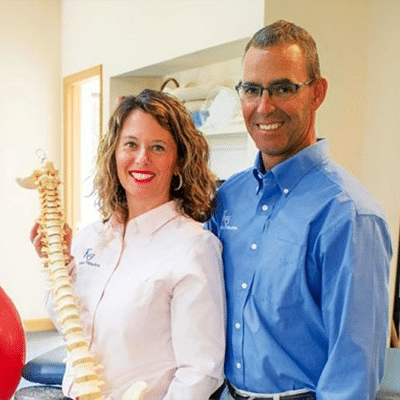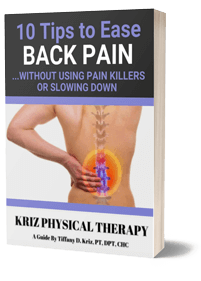Your ankles are put under a lot of stress during a run, and if you are struggling with niggling ankle pain after running, it can leave you with soreness and discomfort for days afterwards.
As well as the physical pain in your ankles after running, your performance can suffer too.
Paranoid and worried about ankle pain, you aren’t able to push yourself to a faster time, or longer distance.
We work with lots of runners at our Bonita Springs clinic, and know that as well as a healthy hobby, it’s also a great challenge and rewarding feeling when you can beat your personal record, or move up the pack at race events.
With ankle pain, you aren’t able to do this – but our team are here to help and in this blog we share how to reduce ankle pain after running!
4 Common Causes Of Ankle Pain After Running
In our experience of working with lots of runners, pain in the ankles is usually caused by one of the following four scenarios:
1 – Ankle Sprain
An ankle sprain is when you ligaments that connect your ankle bone to other bones in your foot, and lower leg are stretched or torn.
Symptoms Of An Ankle Sprain
If you’ve sprained your ankle, the common symptoms include (i) pain, (ii) swelling, (iii) bruising, (iv) and an inability to move, or put weight on your ankle.
Common Causes Of An Ankle Sprain
Ankle sprains are usually the result of trauma, such as a trip or fall. For runners, ankle sprains are far more common amongst outdoor runners as the running surface can be uneven, and change during the run leading to a higher chance of rolling your ankle, or losing your footing.
Ankle sprains are much less common for track, or indoor runners.
2 – Ankle Strain
Similar to ankle sprain, an ankle strain is when your tendons that connect your ankle bone to muscles in your foot and lower leg are torn or stretched.
Symptoms Of An Ankle Strain
If you’ve strained your ankle, you will likely experience some, if not all of these symptoms including (i) pain, (ii) swelling, (iii) cramping, (iv) muscle spasms (v) and an inability to move, or put weight on your ankle.
Common Causes Of An Ankle Strain
Ankle strains are similar to ankle sprains in the sense that they are usually the result of an incident.
3 – Tendinitis
Tendinitis is the inflammation or irritation of your ankle tendons, and a very common issue for runners.
Symptoms Of Tendinitis
Tendinitis leads to a dull aching pain in the ankle, and flares up when moving your ankle. So, if you suffer most during runs, this could be a sign that tendinitis is the cause.
You may also notice a small amount of swelling around the ankle, and it can be tender to touch or move.
Common Causes Of Tendinitis
For runners, tendinitis tends to be caused by overuse of the ankle – when running either too far, or too often. This can mean that tendinitis is most likely to occur for runners when they are trying to increase the number of runs they do each week, or increasing the distance of their runs.
To overcome this, it’s really important to gradually increase your running mileage, and this should mean your ankles are able to adapt to the increased distance without pain or discomfort.
Another common cause of tendinitis for runners is due to their footwear. Incorrect footwear, or footwear that is damaged, leads to more stress on the ankle tendons whilst running and increases the chance and severity of tendinitis.
Finally, your foot itself can mean you are more vulnerable to tendinitis. If you have low foot arches (or flat feet), this increases the pressure on your ankle tendons making tendinitis more likely.
4 – Stress Fracture
The final common cause of ankle pain after running is a stress fracture. This is less common, however is still something our team treat frequently for runners in our area.
Symptoms Of A Stress Fracture
If you’ve suffered a stress fracture in your ankle, you will notice an increasing pain as your move, which lessens with rest. You may also notice a little swelling, and there could also be bruising around your ankle.
Common Causes Of A Stress Fracture
Stress fractures, similar to tendinitis, are typically overuse injuries through running too far (either in one run, or over the week).
A change in running surface can also trigger stress fractures so if you’ve moved from a treadmill to running the streets, the harder surface and bigger impact on your ankles could have create a small stress fracture.
Other causes for stress fractures can be poor nutrition, where you aren’t taken in enough Vitamin D and Calcium.
Natural Way To Stop Ankle Pain After Running
To reduce treat ankle pain after running without painkillers, the RICE protocol is a natural way to ease the discomfort, minimise swelling and speed up recovery.
RICE stands for Rest, Ice, Compress, and Elevate.
Rest simply means keeping weight off your ankle as much as possible. This will give your ankle time to recover without further stress or pressure on any damaged, or inflamed areas.
Ice is a drug-free way to relieve ankle pain, as well as reduce swelling. Applying an ice pack for 20 minutes, several times throughout the day, is a safe, and proven form of ankle pain relief.
Compress your ankle using an elasticated bandage or an ankle compression sleeve. The compression should be snug, but not feel tight.
Elevate your ankle, and try to keep it above the height of your heart. So when laying in bed, use a pillow to raise your foot.
By using the RICE protocol, you should be able to stop ankle pain after running naturally if it’s a minor injury, or irritation.
When To Get Help To Relieve Ankle Pain After Running
To recover from more serious ankle injuries, seek professional help from our team if:
- Your ankle pain lasts for more than 3 days
- You struggle to run after a week or rest
- Your ankle becomes very red (which can be a sign of infection)
- You can’t stand, or place weight on your ankle
- Your ankle feels unstable, tingly or numb
- You have a history of ankle problems
If you try the RICE protocol, and aren’t back to running pain-free, or suffer with any of these other symptoms, it is unlikely to fully heal itself.
Whilst you may be hoping it will go away on it’s own, injuries can often worsen, or keep coming back, meaning that you can’t improve your time, your distance and unable to enjoy your running.
But an ankle injury isn’t something you have to put up with, and ankle pain after running can be treating without painkillers by our team.
The Most Effective Way To Treat Ankle Pain After Running
For long term relief from ankle pain, physical therapy is a safe, drug-free way that helps lots of runner like you.
To find out more about physical therapy, and discover exactly how you can get back to pain-free running so you can beat your personal best, stay healthy and feel fit, arrange a free discovery visit.
Scheduling with us is quick and easy.
Plus, our therapy sessions are flexible, making us ideal for anyone who manages a busy schedule.
Call our offices today at 239-992-6700 to schedule an appointment or arrange a free discovery visit.
If you prefer to speak to a physical therapist from the comfort of your own home, arrange a free telephone consultation.
We are also offering a limited number of free footwear assessments, which are perfect for runners with ankle pain.
In a footwear assessment, you can discover exactly how your feet are affecting your running, and whether your footwear is the root cause of your ankle pain.
Call our offices today at 239-992-6700 – but HURRY – There are only 6 free footwear assessment available!
More Natural Ways To Stop Ankle Pain
At Kriz Physical Therapy, P.A., we have a variety of other natural ways to stop ankle problems, for FREE, which you can access online.
Grab a copy of our free Downloadable Ankle And Foot Pain Report written by our founder, Michael Kriz, which explains simple strategies to ease ankle and foot pain.
You can also read our other popular blogs such as: Are Your Shoes Causing Your Ankle Pain? or Sports Performance and Physical Therapy: Two Peas in a Pod
On social media? Head to our Kriz Therapy Facebook Page or Kriz Therapy Instagram Page and follow us for regular tips and advice.




